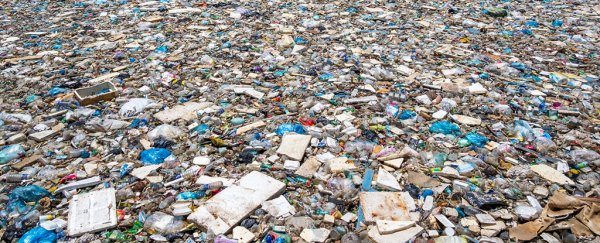If you didn't know already, we have bad news – the plastic recycling industry is severely under-performing. Only 9 percent of plastic waste ever produced has been recycled. Around 12 percent has been burnt, leaving 79 percent of all plastic ever produced still out there in the world.
While we work out how to be less reliant on these materials, researchers have also been investigating how to reuse one of the most common types of plastic – polyolefin – by turning it into fuel.
"Single-use plastics impose an enormous environmental threat, but their recycling, especially of polyolefins, has been proven challenging," researchers from the University of Delaware (UD) write in a new paper.
"We report a direct method to selectively convert polyolefins to branched, liquid fuels including diesel, jet, and gasoline-range hydrocarbons."
This is definitely not the first time scientists have turned plastic into fuel (in fact, we've been reporting on these methods for years), but like most material sciences, the goal is to get the most plastic converted into the most fuel, at the cheapest cost and using the least amount of resources to do so.
The new technique ticks plenty of those boxes: it uses 50 percent less energy than similar technologies, can be done at temperatures of a normal kitchen oven, and doesn't involve adding carbon dioxide into the atmosphere. All exciting steps in the right direction.
"Plastic waste is a serious environmental issue. I believe that this research can help lead to better methods of plastic repurposing," said Andrew Danielson, a UD chemical engineer.
The team uses a chemical process called hydrocracking to break down the carbon bonds in the plastic, using a catalyst made up of minerals called zeolites and mixed metal oxides.
 (Liu et al., Science Advances, 2021)
(Liu et al., Science Advances, 2021)
Mixed metal oxides are used to break down large molecules, while zeolites foster the formation of branched molecules – a technique which makes the plastic goop more easily translated into an end product.
"Alone these two catalysts do poorly. Together, the combination does magic, melting the plastics down and leaving no plastic behind," UD biomolecular engineer Dion Vlachos said.
"These are not exotic materials, so we can quickly start thinking about how to use the technology."
As an added bonus, the team's process doesn't need to separate different types of plastics, which is helpful when many of the plastic products now sold are multicomponent - either as composites, blends, or having multiple layers of different types.
This is far from the end of plastic waste, of course, and only deal with one symptom of the larger issue. To create a circular economy, we have to eventually stop pulling oil from the ground to make plastic, which is something that the researchers are well aware of.
"As this circular economy gets going, the world will need to make fewer original plastics because we will be reusing materials made today into the future," Vlachos said.
"We want to use green electricity to drive the chemical processing involved in making new things … that's where we are headed over the next 10 to 20 years."
Sounds like it is time to get started.
The research has been published in Science Advances.
